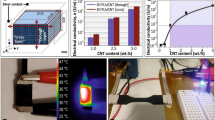Abstract
Blending polyaniline (PAn) with a host polymer has the advantage of reducing the amount of polyaniline necessary for conductivity, increasing the stability of this conduction, and enhancing the overall mechanical integrity, versatility, and processability of PAn. PAn blends have generally been observed to be immiscible, reducing many of the above mentioned advantages. In this work, PAn was solution blended with poly(vinyl pyrrolidone) (PVP) in either NMP or DMAc, both polar solvents with an amide linkage. We have found PAn to be miscible with PVP under certain processing conditions. The extent of this compatibility and resulting mechanical properties were assessed by DMA, DSC, TGA, SAXS, and light microscopy. DSC thermograms exhibit a single Tg for all blends ranging from 3 to 30 % by weight PAn. Light microscopy and SAXS also suggest no phase separation. TGA results show that NMP binds very tightly to both PAn and PVP, with solvent cast blends retaining up to 20 wt% NMP, even after relatively vigorous drying. Electrical conductivity measurements of cast films show conductivity to range from 10−3 to 2 S/cm over the same composition range.
Similar content being viewed by others
References
C.Y. Yang, Y. Cao, P. Smith, and A.J. Heeger, ACS Polymer Preprints, 34(1), 790 (1993).
Y. Cao and A.J. Heeger, Synth. Met., 52, 193 (1992).
Y. Cao, P. Smith, and A.J. Heeger, Synth. Met., 48, 91 (1992).
A. Andreatta and P. Smith, Synth. Met., 55, 1017 (1993).
S.Y. Yang and E. Ruckenstein, Synth. Met., 59, 1 (1993).
E. Ruckenstein and S.Y. Yang, Synth. Met., 53, 283 (1993).
R.L. Elsenbaumer, U.S. Patent No. 4, 983, 322 (1991).
C.C. Han, R.L. Elsenbaumer, L.W. Shacklette, and G.G. Miller, International Patent Application, No. WO 92/11644 (1992).
D.C. Trivedi and S.K. Dhawan, Synth. Met., 58, 309 (1993).
Y.-H. Liao and K. Levon, ACS PMSE Proc., 69, 327 (1993).
B.D. Malhotra, S. Ghosh, and R. Chandra, J. Appl. Polym. Sci., 40, 1049 (1990).
Y. Kang, M.-H. Lee, and S.B. Rhee, Synth. Met., 52, 319 (1992).
L. Sun, S.C. Yang, and J.-M. Liu, ACS Polymer Preprints, 33(2), 379 (1992).
J.-C. Chiang and A.G. MacDiarmid, Synth. Met., 13, 193 (1986).
W.B. Stockton and M.F. Rubner, to be published in “Polymer Preprints”, ACS Meeting, San Diego, March 1994.
S.-A. Chen and H.-T. Lee, Synth. Met., 57, 1040 (1993).
Acknowledgments
The authors acknowledge the Center for Materials Science and Engineering at MIT, and the National Science Foundation, for partial support of this work.
Author information
Authors and Affiliations
Rights and permissions
About this article
Cite this article
Stockton, W.B., Rubner, M.F. Electrically Conducting Compatible Blends of Polyaniline / Poly(Vinyl Pyrrolidone). MRS Online Proceedings Library 328, 257–262 (1993). https://doi.org/10.1557/PROC-328-257
Published:
Issue Date:
DOI: https://doi.org/10.1557/PROC-328-257




